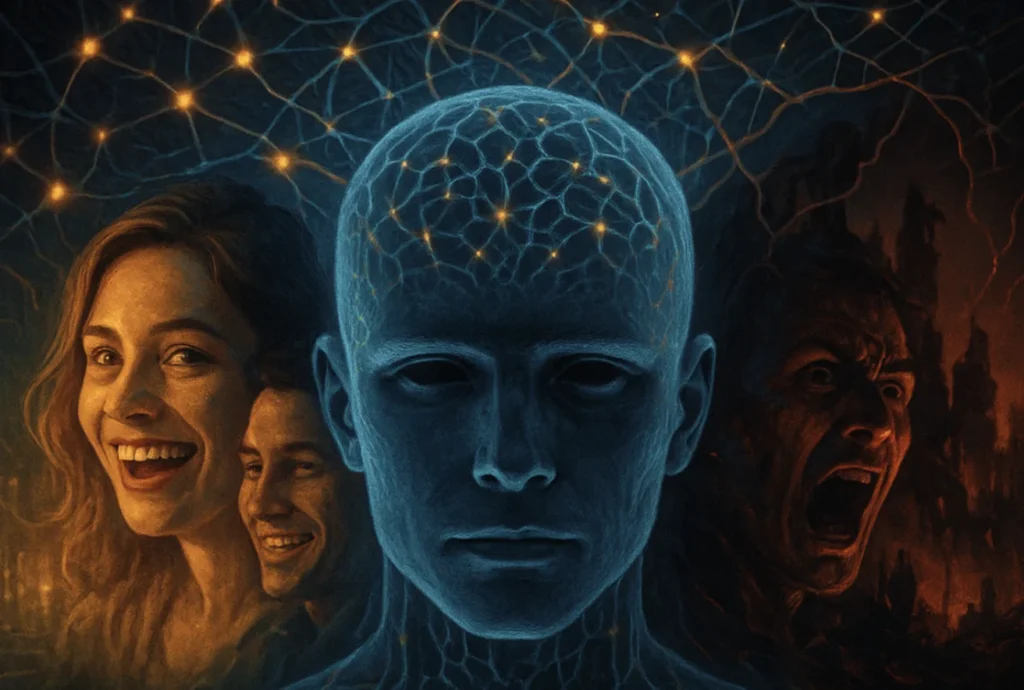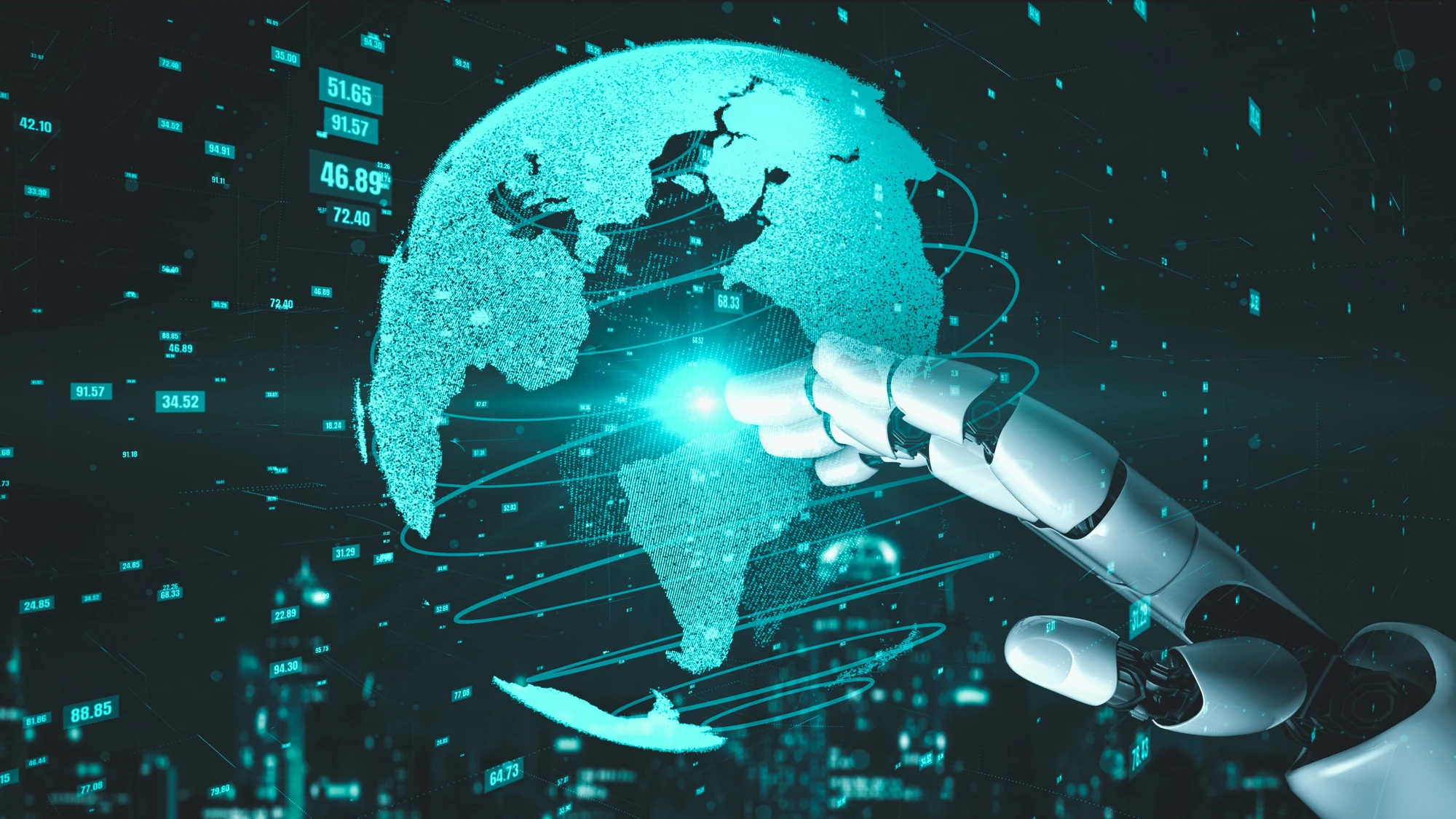As AI takes on the role of imagination, the article asks: what happens to human agency in a world where we are constantly shown the futures we most desire — or dread?
Seeing Is Believing: Visualisation and Behaviour
In The Man in the High Castle, the 1962 novel adapted into a TV series of the same name in 2015, the reader is introduced to a world in which the Nazis and their Japanese allies won the Second World War. By 1962, when the book is set, the two powers have carved out almost the entirety of the world between each other, ruling their billions of subjects through horrific and dystopic regimes. Central to the plot is a banned novel, The Grasshopper Lies Heavy, which gives a highly detailed alternate reality in which the Allies have in fact won the war, and Nazi Germany, along with the Japanese Empire, are simply relics of the past. In the TV series version, the alternative reality is presented to people in the form of videotapes, showing Great Britain, America, Russia, and their allies prevailing over the Nazis. In both the book and the series, the Nazis are committed to eradicating these dangerous portrayals of a new world, while resistance groups against them cherish, protect, and disseminate them, as they become a formidable means through which to inspire and recruit others to their cause, showing them that another reality is possible. As the saying goes: Seeing is believing. In the age of AI, if anything imaginable is able to be seen, is it also possible that anything imaginable can be believed?
Among many other messages, The Man in the High Castle conveys to readers that once humans can vividly visualise or even see a different reality, the impossible can quickly become perceived as possible, and this can profoundly and powerfully animate them into action – either to realise such realities or prevent them from taking place. Cognitive psychological research shows that the more vivid and detailed mental imagery is, the greater the impact it has on human behaviour. The availability heuristic, for example, is an identified cognitive shortcut whereby an individual judges the likelihood or probability of an event based on how many examples or cases come to mind. In positive and motivational psychology, visualisation techniques are used to foster greater optimism, resilience, and commitment towards achieving specific goals. Conversely, human behaviour can also be influenced significantly through the use of fear appeals, whereby negative outcomes, consequences, or futures are visualised or vividly presented so as to encourage action to prevent them from taking place. Just think about the highly graphic images shown on cigarette packs, used to deter smokers from continuing their habit, or of political TV advertisements that present the dark future its viewers will live in if the other candidate wins (here is a great example from the 2020 US Presidential campaign.)
Dreams and Nightmares as Motivation
The advances in and widespread access to AI image and video generation software may result in millions, if not billions of people across the globe, being shown visual presentations of their biggest dreams and their worst nightmares, resulting in profound behavioural change.
In fact, this has already begun. In 2019, FaceApp, an app which generated highly realistic photos of what its users would look like at an elderly age, became highly popular and its users, having been exposed to their 80-year-old selves, expressed increased motivation to save up for retirement. A more intentional example can be found in the healthcare and fitness space, where apps like EnvisionBody and FutureMe allow users embarking on health or weight loss journeys to look at hyper-realistic images of what they would likely look like were they to remain consistent with their fitness goals. Research has shown positive behaviours can result from these sorts of visualisations, but AI is now making these visualisations very “real” and easily accessible, meaning that almost anyone can reap these benefits should they wish. Of course, other applications of AI image and video generation can take the route of changing human behaviour through fear or anger appeals instead. Right wing groups concerned with the “Islamification” of Europe share detailed and realistic AI videos showing a future “if nothing is done”, including Islamic flags draped over the Eiffel Tower, pork being banned in supermarkets, and Friday prayers taking place in front of the Champs Elysees.
We can find another, accidental, example of this from earlier this year, when an AI generated video depicting President Trump’s “vision” for Gaza, owned by the US, depopulated of Palestinians, and turned into a Dubai-style tourist attraction filled with hotels and luxury, generated an incredibly hostile reaction from audiences all over the world, including even members of his own base. While Trump had verbally outlined his proposal for Gaza some days prior, criticism towards his proposal ramped up significantly only after the video was shared online. It became a mobilising force on the internet for opponents of his vision who were significantly animated after seeing the somewhat dystopic and creepy depiction. This serves as a great example of an AI-generated “nightmare” working as a fear appeal to mobilise those who seek to prevent it from ever taking place. In April, following Trump’s imposition and scaling-up of tariffs against China, another, significantly more realistic, AI video went viral depicting overweight Americans working, miserably and dejectedly, in factories producing goods that are typically imported to the US from China. The video served as a means through which Chinese audiences, along with some American ones too, could mock the Trump Administration’s trade policies but also highlighted the long-term unfeasibility of it – this AI generated nightmare appealed to very few Americans, the vast majority of whom do not want to work in factories.
Having looked at the phenomenon of AI generated images and videos and their interactions with and impacts on human psychology and behaviour, it is worth imagining how this technology, which is widely accessible and relatively easy to use, might be used in the coming years.
Hyper-Personalised Persuasion
One way in which it is already starting to be used, as mentioned previously, is the area of health. Patients who are at a crossroads with their health, whether it be due to smoking, obesity, or drug abuse, could be shown two contrasting visions of their future, a dream and a nightmare, to spur them into action. The AI used can be fed thousands of details from their lives, whether it be photos or videos of their homes, loved ones, daily routines. The “dream” video can show them “cured”, or at least healthier and happier, more active, more attractive, and more able to do the things that they love, or that they aspire to do. The “nightmare” would show the gradual and horrific worsening of their conditions, the negative impact it has on them, their lives, routines, and their loved ones. In a similar vein, this can be used not only for those with unhealthy habits, but to anyone who wishes to motivate themselves powerfully towards an ideal future and away from one they wish to avoid. Therapists, life coaches, or simply the individuals in question themselves could have videos created showing a person’s “dream life” and the positive actions it resulted from, making them more motivated to commit to the habits required to achieve it. Conversely, they can be presented with the “nightmare” of failure, a powerful and detailed fear appeal that presents them with the life outcomes they wish most to avoid. Of course, there are many ways in which this method could backfire too and harm the people it was supposed to help.
In the arena of warfare, AI image and video generation has a lot of potential to be applied in psychological warfare. Imagine a city about to be under siege from an invading army, currently making its way to its outskirts. The citizens will be presented with two options: surrender, resulting in a peaceful transition of control of the city, or the mass destruction of their homes and the loss of countless lives as the enemy army successfully, but brutally, conquers the city. Now imagine, that before this city’s leaders are to make their choice, devices all over the city are airdropped two videos, both of which are created by an AI that has been fed extremely detailed maps, videos, and photos of the city, along with photos of its inhabitants, scraped from social media. The first video shows everything remaining as is, with the actual inhabitants shown to be smiling, treated well, and going about their daily lives. The second video shows, in excruciating detail, the destruction of homes, businesses, and places of worship all too recognisable to the audience, and the deaths of the city’s actual citizens – with them either witnessing the deaths of friends and loved ones, or even of themselves. One can only imagine the chaos and destruction of morale caused.
In advertising, which, as Don Draper put it, is based on happiness, AI image and video generation can be used to target consumers on a much more personal level than ever before – playing in front of them their innermost desires and showing how they’re achievable just by purchasing the right product. Imagine a Facebook or YouTube user is targeted by an AI advertising company which has access to images of them, their home, their loved ones, and their peers. A woman is shown an advert for a perfume before she can watch a YouTube video, which depicts her applying the fragrance while her husband is being much more affectionate towards her and taking her out for a weekend holiday at a luxury hotel. A man is shown an advert for a brand new car – with him driving the car and the woman, whose Instagram profile he visits frequently, is seated next to him, looking at him longingly. A teenager sees a Nike advert for football shoes, featuring him in his local park scoring goal after goal and gaining praise and validation from his peers. There has been significant research already showing how much more effective advertising can be when it is tailored to demographic and psychographic profiles, it stands to reason that those tailored to individual-level desires and fears might well be all the more powerful.
Similarly, in political advertising, the same techniques can be used to influence the outcome of elections. If a target voter audience includes neurotic mothers in middle class neighbourhoods, target them with an ad showing crimes taking place in the very neighbourhoods they live in and where their children go to school, explaining that this is the future that awaits her if the opposition wins. If the target voter audience includes extraverted, conscientious working class young men with dreams of entrepreneurship, show them a future in which they succeed thanks to the policies that will be implemented by the right candidate. Even before AI reaches the capability to easily make videos targeting people at a truly individual level, it can allow for much more granular audience segmentation where instead of there being ads targeting a dozen or so target audiences, they can be made to target hundreds or thousands of them.
What happens when AI imagines for us?
These examples illustrate the potency of AI generated images and videos in the context of achieving behavioural outcomes from their audiences and how it is likely we will see this application of AI. If this is to be a major use of AI that impacts all of us in our daily lives, then we need to think about what it means to live in a world where we are constantly being confronted with our dreams and nightmares. Will we become overly stimulated at first and then desensitized? Will we end up making better decisions or will this actually weaken our critical thinking abilities and make us more pliant, more easily manipulable consumers and voters? Indeed, what will this do to our imaginations? Will we fail to exercise them now that the imagining is being done for us? Finally, will this actually expand our minds to new ways of thinking and new possibilities, just like it had done for the rebels fighting fascism in The Man in the High Castle, or will it reinforce our biases and worldviews, making us more rigid and less open to, capable of, or interested in changing our minds and the world around us?




